Gold Pops As Inflation Stops And The Economy Flops

Image Source: Pixabay
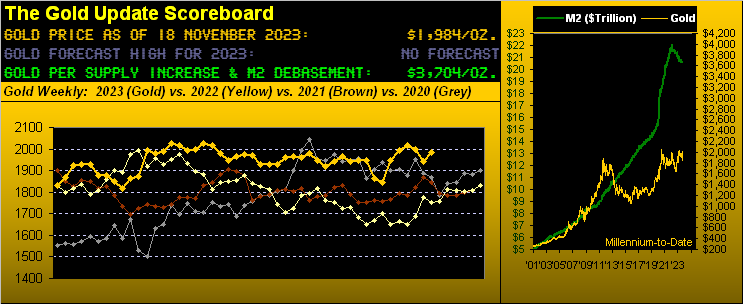
Just as an advertisement for the San Francisco Examiner said some 40 years ago, "a lot can happen between 9 and 5." And relative to just this past week, this is perfectly analogous to the state of gold, inflation and the economy, “a lot can happen between Monday and Friday.” Just this week, the following occurred:
- Gold, above support, popped
- Inflation abruptly stopped
- The economy frightfully flopped
The important number to keep in mind seems to be 3000. The price of gold settled for the week at 1984. Yet, as you can see in the chart above, the yellow metal’s dollar debasement value is 3704.
Perhaps the significance of 3000 could instead refer to the value of the S&P 500, which is now around 4514. The inevitable reversion of the index’s calculated price/earnings ratio (43.8x) to our historical 66-year mean (22.7x incorporating Bob Shiller’s CAPE pre-2013) brings the S&P well sub-3000.
Furthermore, as we've discussed before, were it not for the massive monetary infusion to counter COVID-19, the S&P 500, by our 50-year regression channel, would be in the high 2000 range today, a level otherwise gratefully accepted by the investing community had there been no pandemic monetary response.
Regardless, let’s break down gold’s pop, inflation’s stop, and the economy’s flop.
Per the opening bullet point, this past week saw gold pop back and settle above the green 1980-1922 support zone, with the recent price action resting at the 1984 mark and the week’s high being 1996 (i.e., just 93 points below the Aug. 7, 2020 all-time high of 2089).
In the chart below, gold's weekly bars from one year ago to present are illustrated. The blue dots indicated that the long-term trend is firmly in place, with a lot of underlying safe space surrounding it.
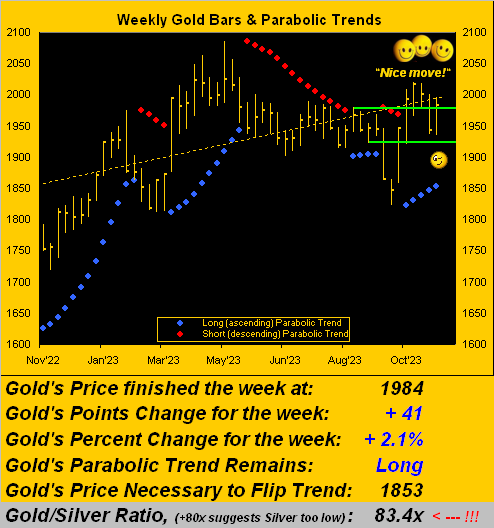
Moreover, we can see that a buy signal has been provided by gold's monthly bars. While this is not a formal recommendation, it could be worth consideration.
The following chart shows the signal highlighted in the lower right section. This is because the green track has crossed above the double-center line. Across the past 28 calendar years, this up-cross has occurred 11 times. The average maximum points follow-through is +264, but with this warning: three of the past four such long signals have garnered at most +50 points of additional gain.

Now, let's discuss inflation's stop. In concert with October’s retail inflation having come to a halt whilst recording wholesale deflation (the Producer Price Index registering -0.5%), financial media swiftly declared the Federal Reserve’s interest rate hikes as having come a conclusion, with cuts commencing next year.
As we prefer to actually do the math, we have come up with the following three-panel graphic of monthly “headline” inflation reports from a year ago to date (note that the Personal Consumption Expenditures report lags the PPI and CPI by one reporting month). Our focus for each panel is the directional slope of the respective dashed regression trendlines.
For both the PPI and CPI, their slopes are rising, and their October figures are quite the deviations from the trendlines. This may imply a snap-back to the upside come the November numbers. The “core” measures (not displayed) for October are as follows: PPI was unchanged, CPI was +0.2%, and September's PCE was +0.3%.

Now, let's move on to discuss the economy’s flop. This past week, Our StateSide Economic Barometer got summarily skewered. Now, here’s the picture from one year ago to date, with the S&P (illustrated by the red line) illogically ignoring overvaluation.
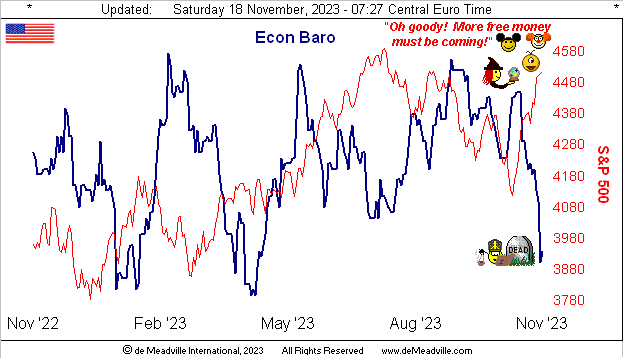
As we’ve noted since COVID-19, the economic barometer doesn’t lead the stock market as it did during the prior 22 years from 1998 into 2020. The monetary injection post-pandemic essentially equaled the increase in the market capitalization of the S&P 500, and we’ve thus been awash in liquidity ever since. Why, not even Moody’s — a week ago citing that U.S. credit risk “...may no longer be fully offset by the sovereign’s unique credit strengths..” — can stop the stampeding S&P.
Since the Econ Baro’s inception back in ’98, there have been just nine other drops of this magnitude across a 12-trading day span. All have led to fairly imminent — however not always overwhelming — price declines in the S&P. That stated, the most recent such decline occurred just over a year ago as of May 22, 2022. Then, on June 17, the S&P had fallen -521 points (-12.5%).
Whether that repeats — with financial media missives now suggesting a record S&P high is nigh (i.e. above the 4819 level achieved on Jan. 4, 2022) — depends upon the investing whims of news followers vs. math doers. Neither overlook that the U.S. “riskless” 3-month T-Bill still yields an annualized 5.233% per Friday's close.
Either way, as of the time of writing, the S&P 500 is “extremely textbook overbought” (based on our concoction of John Bollinger’s Bands, along with standardized Relative Strength and Stochastics), and the S&P 500 futures settled on Friday at +229 points above their smooth valuation line.
The S&P’s aforementioned P/E was 43.8x on Friday. Recall the P/E rate as the S&P topped pre-DotComBomb back in March 2000: 43.2x. Today, this is one perpetually scary/expensive stock market. And with Q3 earnings season having just ended, in collecting bottom lines for 1,860 companies, only 51% improved year-over-year. Specifically 446 S&P constituents, a percentage of 64%, improved. But given “it’s the S&P,” should not 100% have improved?
Meanwhile, the next graph of the precious metals space is a two-panel demonstration of gold's daily bars from the last three months ago to date on the left, and likewise for silver on the right. Of note are gold’s “Baby Blues” of trend consistency having actually gone negative while the price has risen. This is because the 21-day red trendline has rotated to negative. We often say to “follow the blues,” however, in this case, given the positive pricing track for gold, we’re not really looking for much downside.
Meanwhile, silver's red trendline has rotated from negative to flat, with the rightmost baby blue dot sitting on the 0% axis. Also, as penned this past Thursday, “...silver’s daily parabolics flipped to long effective today’s open: the average maximum follow-though of the past 10 such studies (either long or short) is 1.695 points...”
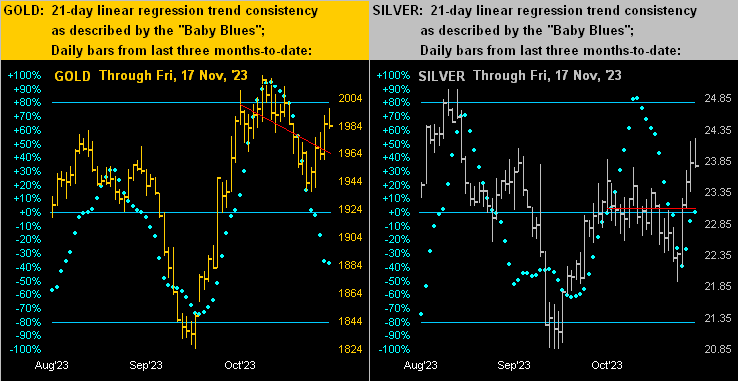
As for the 10-day market profiles, which denote prices at the most robust levels of volume, both panels below look healthy for gold silver. In fact, for the grey metal, the +6.6% gain for this past week (vs. +2.1% for the yellow metal) served to reduce the gold/silver ratio from 87.1x to 83.4x. Still, the century-to-date ratio is 67.9x, leaving silver plenty of room to outperform gold on the upside.
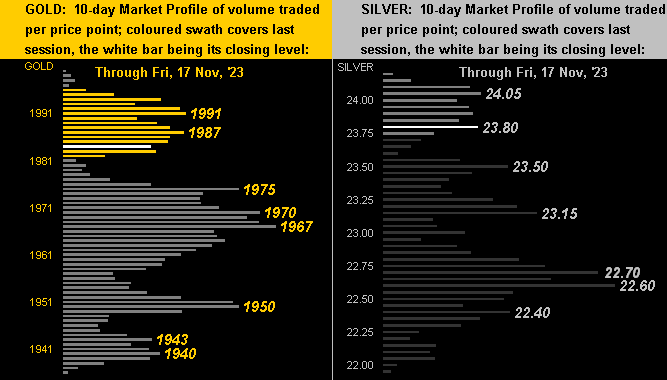
In sum, gold once again has a chance to go for an all-time high. The S&P is due for a dive. And certainly both “ought to be” similarly priced right around 3000, at least if you do the math.
More By This Author:
Gold’s Bang On Time Dive
Gold’s Post-Geopolitical Pullback
Gold: Range-Bound? Or Moon-Bound?
Disclaimer: If ever a contributor needed a disclaimer, it's me. Indeed, your very presence here has already bound you in the Past, Present and Future to this disclaimer and to your acknowledging ...
more


